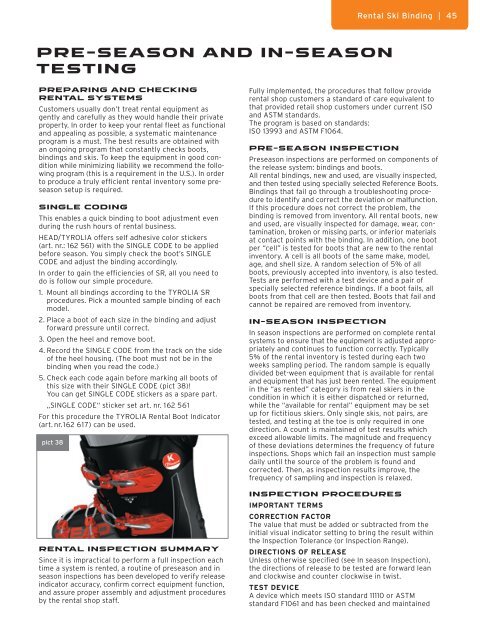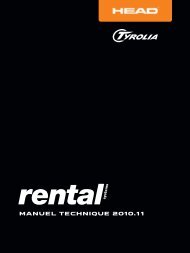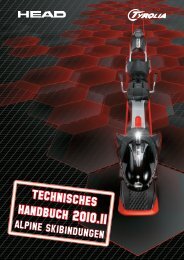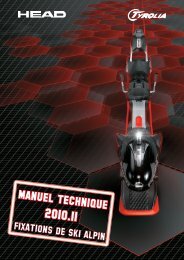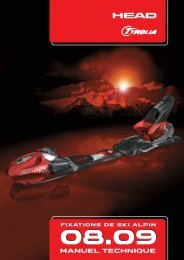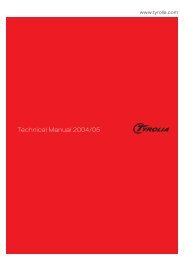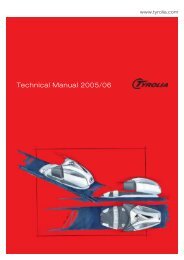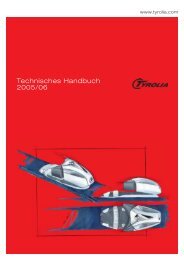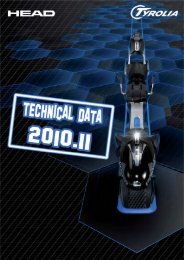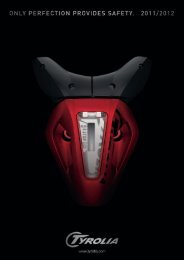You also want an ePaper? Increase the reach of your titles
YUMPU automatically turns print PDFs into web optimized ePapers that Google loves.
45 | Rental Ski Binding<br />
Pre-Season and In-Season<br />
testing<br />
Preparing and Checking<br />
Rental Systems<br />
Customers usually don’t treat rental equipment as<br />
gently and carefully as they would handle their private<br />
property. In order to keep your rental fleet as functional<br />
and appealing as possible, a systematic maintenance<br />
program is a must. The best results are obtained with<br />
an ongoing program that constantly checks boots,<br />
bindings and skis. To keep the equipment in good condition<br />
while minimizing liability we recommend the following<br />
program (this is a requirement in the U.S.). In order<br />
to produce a truly efficient rental inventory some preseason<br />
setup is required.<br />
SINGLE CODING<br />
This enables a quick binding to boot adjustment even<br />
during the rush hours of rental business.<br />
HEAD/TYROLIA offers self adhesive color stickers<br />
(art. nr.: 162 561) with the SINGLE CODE to be applied<br />
before season. You simply check the boot’s SINGLE<br />
CODE and adjust the binding accordingly.<br />
In order to gain the efficiencies of SR, all you need to<br />
do is follow our simple procedure.<br />
1. Mount all bindings according to the TYROLIA SR<br />
procedures. Pick a mounted sample binding of each<br />
model.<br />
2. Place a boot of each size in the binding and adjust<br />
forward pressure until correct.<br />
3. Open the heel and remove boot.<br />
4. Record the SINGLE CODE from the track on the side<br />
of the heel housing. (The boot must not be in the<br />
binding when you read the code.)<br />
5. Check each code again before marking all boots of<br />
this size with their SINGLE CODE (pict 38)!<br />
You can get SINGLE CODE stickers as a spare part.<br />
„SINGLE CODE“ sticker set art. nr. 162 561<br />
For this procedure the TYROLIA Rental Boot Indicator<br />
(art. nr.162 617) can be used.<br />
pict 38<br />
<strong>RENTAL</strong> INSPECTION SUMMARY<br />
Since it is impractical to perform a full inspection each<br />
time a system is rented, a routine of preseason and in<br />
season inspections has been developed to verify release<br />
indicator accuracy, confirm correct equipment function,<br />
and assure proper assembly and adjustment procedures<br />
by the rental shop staff.<br />
Rental Ski Binding | 45<br />
Fully implemented, the procedures that follow provide<br />
rental shop customers a standard of care equivalent to<br />
that provided retail shop customers under current ISO<br />
and ASTM standards.<br />
The program is based on standards:<br />
ISO 13993 and ASTM F1064.<br />
PRE-SEASON INSPECTION<br />
Preseason inspections are performed on components of<br />
the release system: bindings and boots.<br />
All rental bindings, new and used, are visually inspected,<br />
and then tested using specially selected Reference Boots.<br />
Bindings that fail go through a troubleshooting procedure<br />
to identify and correct the deviation or malfunction.<br />
If this procedure does not correct the problem, the<br />
binding is removed from inventory. All rental boots, new<br />
and used, are visually inspected for damage, wear, contamination,<br />
broken or missing parts, or inferior materials<br />
at contact points with the binding. In addition, one boot<br />
per “cell” is tested for boots that are new to the rental<br />
inventory. A cell is all boots of the same make, model,<br />
age, and shell size. A random selection of 5% of all<br />
boots, previously accepted into inventory, is also tested.<br />
Tests are performed with a test device and a pair of<br />
specially selected reference bindings. If a boot fails, all<br />
boots from that cell are then tested. Boots that fail and<br />
cannot be repaired are removed from inventory.<br />
IN-SEASON INSPECTION<br />
In season inspections are performed on complete rental<br />
systems to ensure that the equipment is adjusted appropriately<br />
and continues to function correctly. Typically<br />
5% of the rental inventory is tested during each two<br />
weeks sampling period. The random sample is equally<br />
divided bet-ween equipment that is available for rental<br />
and equipment that has just been rented. The equipment<br />
in the “as rented” category is from real skiers in the<br />
condition in which it is either dispatched or returned,<br />
while the “available for rental” equipment may be set<br />
up for fictitious skiers. Only single skis, not pairs, are<br />
tested, and testing at the toe is only required in one<br />
direction. A count is maintained of test results which<br />
exceed allowable limits. The magnitude and frequency<br />
of these deviations determines the frequency of future<br />
inspections. Shops which fail an inspection must sample<br />
daily until the source of the problem is found and<br />
corrected. Then, as inspection results improve, the<br />
frequency of sampling and inspection is relaxed.<br />
INSPECTION PROCEDURES<br />
IMPORTANT TERMS<br />
CORRECTION FACTOR<br />
The value that must be added or subtracted from the<br />
initial visual indicator setting to bring the result within<br />
the Inspection Tolerance (or Inspection Range).<br />
DIRECTIONS OF RELEASE<br />
Unless otherwise specified (see In season Inspection),<br />
the directions of release to be tested are forward lean<br />
and clockwise and counter clockwise in twist.<br />
TEST DEVICE<br />
A device which meets ISO standard 11110 or ASTM<br />
standard F1061 and has been checked and maintained


